High-Efficiency Photoresponse of Flexible Copper Oxide-Loaded Carbon Nanotube Buckypaper Under Direct and Gradient Visible Light Illumination
Abstract
1. Introduction
2. Experimental Section
2.1. Fabrication of MWCNT BP
2.2. Preparation of CuO NPs and CuO-Filled BP Composites
2.3. Characterization Techniques
3. Results and Discussion
3.1. XRD Analyses
3.2. FE-SEM Analysis
3.3. Electrical Resistivity Measurements
3.4. Photoelectrical Performances of Hybrid CuO-BP Composites
4. Conclusions
Author Contributions
Funding
Data Availability Statement
Conflicts of Interest
References
- Walter, E.C.; Murray, B.J.; Favier, F.; Penner, R.M. “Beaded” Bimetallic nanowires: Wiring nanoparticles of metal 1 using nanowires of metal 2. Adv. Mater. 2003, 15, 396–399. [Google Scholar] [CrossRef]
- Dillon, A.C. Carbon Nanotubes for Photoconversion and Electrical Energy Storage. Chem. Rev. 2010, 110, 6856–6872. [Google Scholar] [CrossRef]
- Dikin, D.A.; Stankovich, S.; Zimney, E.J.; Piner, R.D.; Dommett, G.H.B.; Evmenenko, G.; Nguyen, S.T.; Ruoff, R.S. Preparation and characterization of graphene oxide paper. Nature 2007, 448, 457–460. [Google Scholar] [CrossRef] [PubMed]
- Chung, Y.-C.; Julistian, A.; Saravanan, L.; Chen, P.-R.; Xu, B.-C.; Xie, P.-J.; Lo, A.-Y. Hydrothermal Synthesis of CuO/RuO2/MWCNT Nanocomposites with Morphological Variants for High Efficient Supercapacitors. Catalysts 2022, 12, 23. [Google Scholar] [CrossRef]
- Feng, J.; Xiong, S.; Wang, Y. Atomic layer deposition of hybrid metal oxides on carbon nanotube membranes for photodegradation of dyes. Compos. Commun. 2019, 12, 39–46. [Google Scholar] [CrossRef]
- Picuntureo, M.; García-Merino, J.A.; Villarroel, R.; Hevia, S.A. The Synthesis of Sponge-like V2O5/CNT Hybrid Nanostructures Using Vertically Aligned CNTs as Templates. Nanomaterials 2024, 14, 211. [Google Scholar] [CrossRef] [PubMed]
- Wan, L.; Deng, C.; Zhao, Z.-Y.; Zhao, H.-B.; Wang, Y.-Z. A titanium dioxide–carbon nanotube hybrid to simultaneously achieve the mechanical enhancement of natural rubber and its stability under extreme frictional conditions. Mater. Adv. 2021, 2, 2408–2418. [Google Scholar] [CrossRef]
- Pathak, P.; Park, S.; Cho, H.J. A Carbon Nanotube–Metal Oxide Hybrid Material for Visible-Blind Flexible UV-Sensor. Micromachines 2020, 11, 368. [Google Scholar] [CrossRef] [PubMed]
- Sharafeldin, I.; Rios, S.G.; Ahmed, N.; Alvarado, M.; Vilanova, X.; Allam, N.K. Metal-decorated carbon nanotubes-based sensor array for simultaneous detection of toxic gases. J. Environ. Chem. Eng. 2021, 9, 104534. [Google Scholar] [CrossRef]
- Liu, S.; Shen, Q.; Cao, Y.; Gan, L.; Wang, Z.X.; Steigerwald, M.L.; Guo, X. Chemical functionalization of single-walled carbon nanotube field-effect transistors as switches and sensors. Coord. Chem. Rev. 2010, 254, 1101–1116. [Google Scholar] [CrossRef]
- Zhang, W.D.; Xu, B.; Jiang, L.C. Functional hybrid materials based on carbon nanotubes and metal oxides. J. Mater. Chem. 2010, 20, 6383–6391. [Google Scholar] [CrossRef]
- Huang, Q.; Gao, L. Multiwalled carbon nanotube/BaTiO3 nanocomposites: Electrical and rectification properties. Appl. Phys. Lett. 2005, 86, 123104. [Google Scholar] [CrossRef]
- Flahaut, E.; Peigney, A.; Laurent, C.; Marliere, C.; Chasteland, F.; Rousset, A. Carbon nanotube–metal–oxide nanocomposites: Microstructure, electrical conductivity and mechanical properties. Acta Mater. 2000, 48, 3803–3812. [Google Scholar] [CrossRef]
- Berger, C.; Yi, Y.; Wang, Z.L.; de Heer, W.A. Multiwalled carbon nanotubes are ballistic conductors at room temperature. Appl. Phys. A 2002, 74, 363–365. [Google Scholar] [CrossRef]
- Javey, A.; Jing, G.; Qian, W.; Lundstrom, M.; Dai, H. Ballistic carbon nanotube field-effect transistors. Nature 2003, 424, 654–657. [Google Scholar] [CrossRef] [PubMed]
- Wadia, C.; Alivisatos, A.P.; Kammen, D.M. Materials Availability Expands the Opportunity for Large-Scale Photovoltaics Deployment. Environ. Sci. Technol. 2009, 43, 2072–2077. [Google Scholar] [CrossRef] [PubMed]
- Raizada, P.; Sudhaik, A.; Patial, S.; Hasija, V.; Khan, A.A.P.; Singh, P.; Gautam, S.; Kaur, M.; Nguyen, V.-H. Engineering nanostructures of CuO-based photocatalysts for water treatment: Current progress and future challenges. Arab. J. Chem. 2020, 13, 8424–8457. [Google Scholar] [CrossRef]
- Song, H.J.; Seo, M.H.; Choi, K.W.; Jo, M.-S.; Yoo, J.-Y.; Yoon, J.-B. High-Performance Copper Oxide Visible-Light Photodetector via Grain-Structure Model. Sci. Rep. 2019, 9, 7334. [Google Scholar] [CrossRef]
- Ito, T.; Yamaguchi, H.; Okabe, K.; Masumi, T. Single-crystal growth and characterization of Cu2O and CuO. J. Mater. Sci. 1998, 33, 3555–3566. [Google Scholar] [CrossRef]
- Ghisen, J. Electronic-structure of Cu2O and CuO. Phys. Rev. B. 1988, 38, 11322–11330. [Google Scholar] [CrossRef]
- Dittrich, T.; Belaidi, A.; Ennaoui, A. Concepts of inorganic solid-state nanostructured solar cells. Sol. Energy Mater. Sol. Cells 2011, 95, 1527–1536. [Google Scholar] [CrossRef]
- Kumar, A.; Singh, A.; Kumar, D.; Garg, A.; Dutta, V.; Swami, S.K.; Chaturvedi, N.; Kumar, M. Spray deposited carbon nanotube embedded ZnO as an electrons transport layer in inverted organic solar cells. Hybrid Adv. 2023, 4, 100088. [Google Scholar] [CrossRef]
- Tang, H.; Cao, Q.; He, Z.; Wang, S.; Han, J.; Li, T.; Gao, B.; Yang, J.; Deng, D.; Li, X. SnO2–Carbon Nanotubes Hybrid Electron Transport Layer for Efficient and Hysteresis-Free Planar Perovskite Solar Cells. Sol. RRL 2019, 4, 1900415. [Google Scholar] [CrossRef]
- Xu, J.; Sun, J.L.; Wei, J.; Xu, J. The wavelength dependent photovoltaic effects caused by two different mechanisms in carbon nanotube film/CuO nanowire array heterodimensional contacts. Appl. Phys. Lett. 2012, 100, 251113–2511135. [Google Scholar] [CrossRef]
- Yang, C.-C.; Shen, P.-Y.; Miao, H.-Y.; Huang, C.-Y.; Lin, S.-H.; Weng, J.-H.; Saravanan, L.; Liu, J.-H. Enhancing the Photoelectric Properties of Flexible Carbon Nanotube Paper by Plasma Gradient Modification and Gradient Illumination. Processes 2024, 12, 1449. [Google Scholar] [CrossRef]
- Liu, J.H.; Miao, H.Y.; Saravanan, L.; Wang, L.C.; Tsai, R.H. Fabrication of metal alloy-deposited flexible MWCNT buckypaper for thermoelectric applications. J. Nanomater. 2013, 2013, 635647–6356476. [Google Scholar] [CrossRef]
- Li, N.; Zhang, S.; Ma, H.; Zheng, L. Role of solubilized water in micelles formed by triton x-100 in 1-butyl-3-methylimidazolium ionic liquids. Langmuir 2010, 26, 9315–9320. [Google Scholar] [CrossRef] [PubMed]
- Liu, J.H.; Saravanan, L. Zinc oxide loaded MWCNT buckypaper for the efficient photocurrent generation. Mater. Lett. 2014, 134, 30–33. [Google Scholar] [CrossRef]
- Tian, J.; Li, H.; Xing, Z.; Wang, L.; Luo, Y.; Asiri, A.M.; Youbi, A.O.A.; Sun, X. One-pot green hydrothermal synthesis of CuO–Cu2O–Cu nanorod-decorated reduced graphene oxide composites and their application in photocurrent generation. Catal. Sci. Technol. 2012, 2, 2227–2230. [Google Scholar] [CrossRef]
- Serin, T.; Yildiz, A.; Sahin, S.H.; Serin, N. Extraction of important electrical parameters of CuO. Phys B: Condens. Matter 2011, 406, 575–578. [Google Scholar] [CrossRef]
- Serin, T.; Yildiz, A.; Sahin, S.H.; Serin, N. Multiphonon hopping of carriers in CuO thin films. Phys. B: Condens. Matter 2011, 406, 3551–3555. [Google Scholar] [CrossRef]
- Lee, D.H.; Kim, D.W.; Park, J.G. Enhanced rate capabilities of nanobrookite with electronically conducting MWCNT networks. Cryst. Growth Des. 2008, 8, 4506–4510. [Google Scholar] [CrossRef]
- Zhang, Z.; Yuan, Y.; Liang, L.; Cheng, Y.; Xu, H.; Shi, G.; Jin, L. Preparation and photoelectrochemical properties of a hybrid electrode composed of polypyrrole encapsulated in highly ordered titanium dioxide nanotube array. Thin Solid Films 2008, 516, 8663–8667. [Google Scholar] [CrossRef]
- Zhang, Y.; Sun, X.; Pan, L.; Li, H.; Sun, Z.; Sun, C.; Tay, B.K. Carbon nanotube–ZnO nanocomposite electrodes for supercapacitors. Solid State Ion. 2009, 180, 1525–1528. [Google Scholar] [CrossRef]
- Fuhrer, M.S.; Nygård, J.; Shih, L.; Forero, M.; Yoon, Y.G.; Mazzoni, M.S.C.; Choi, H.J.; Ihm, J.; Louie, S.G.; Zettl, A.; et al. Crossed nanotube junctions. Science 2000, 288, 494–497. [Google Scholar] [CrossRef]
- Ko, Y.H.; Nagaraju, G.; Lee, S.H.; Yu, J.S. Facile preparation and optoelectronic properties of CuO nanowires for violet light sensing. Mater. Lett. 2014, 117, 217–220. [Google Scholar] [CrossRef]
- Scarselli, M.; Scilletta, C.; Tombolini, F.; Castrucci, P.; Diociaiuti, M.; Casciardi, S.; Gatto, E.; Venanzi, M.; De Crescenzi, M. Multiwall Carbon Nanotubes Decorated with Copper Nanoparticles: Effect on the Photocurrent Response. J. Phys. Chem. C 2009, 113, 5860–5864. [Google Scholar] [CrossRef]
- Kecsenovity, E.; Endrődi, B.; Tóth, P.S.; Zou, Y.; Dryfe, R.A.W.; Rajeshwar, K.; Janáky, C. Enhanced Photoelectrochemical Performance of Cuprous Oxide/Graphene Nanohybrids. J. Am. Chem. Soc. 2017, 139, 6682–6692. [Google Scholar] [CrossRef] [PubMed]
- Kecsenovity, E.; Endrődi, B.; Pápa, Z.; Hernádi, K.; Rajeshwar, K.; Janáky, C. Decoration of Ultra-Long Carbon Nanotubes with Cu2O Nanocrystals: A Hybrid Platform for Enhanced Photoelectrochemical CO2 Reduction. J. Mater. Chem. A 2016, 4, 3139–3147. [Google Scholar] [CrossRef]

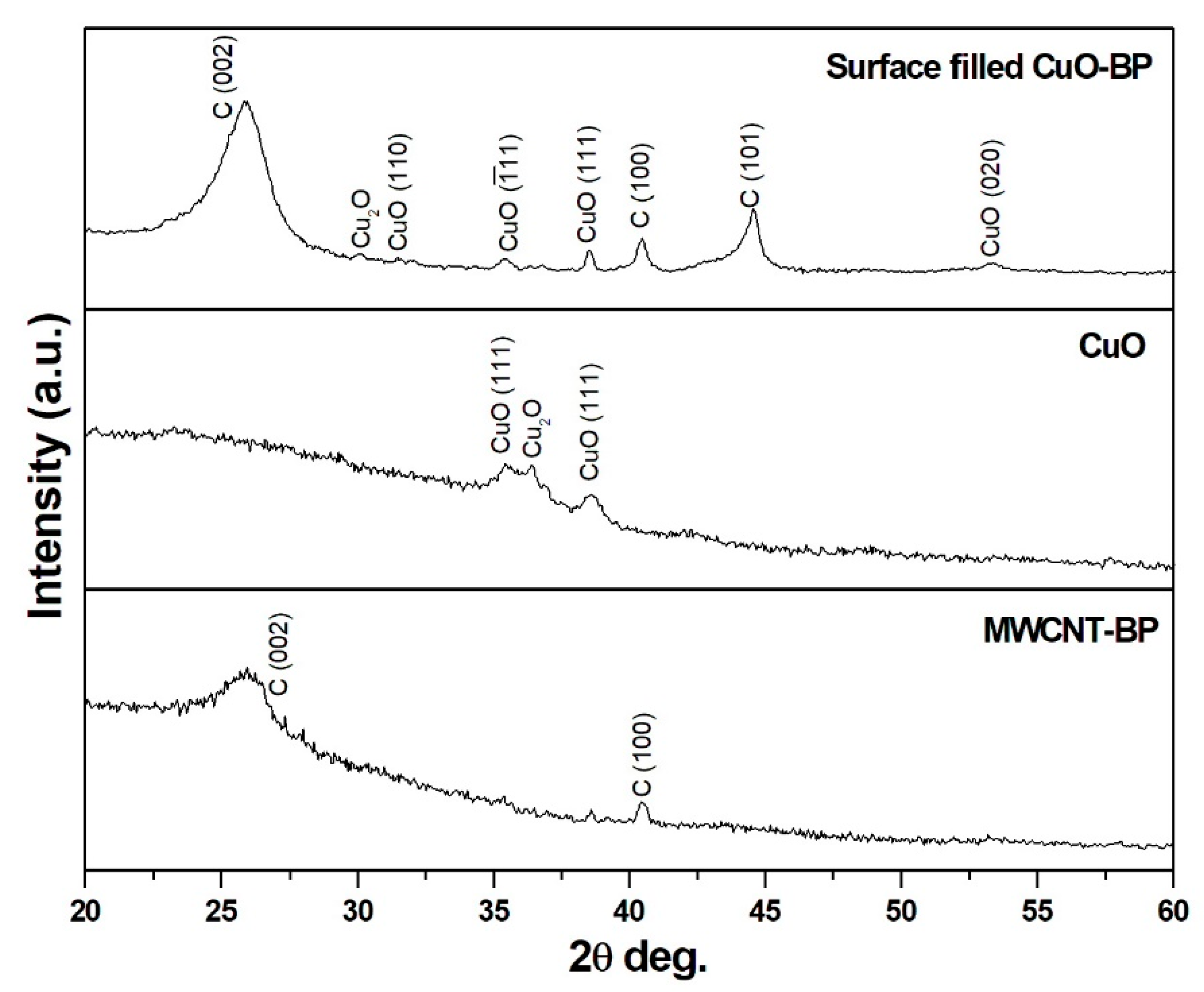


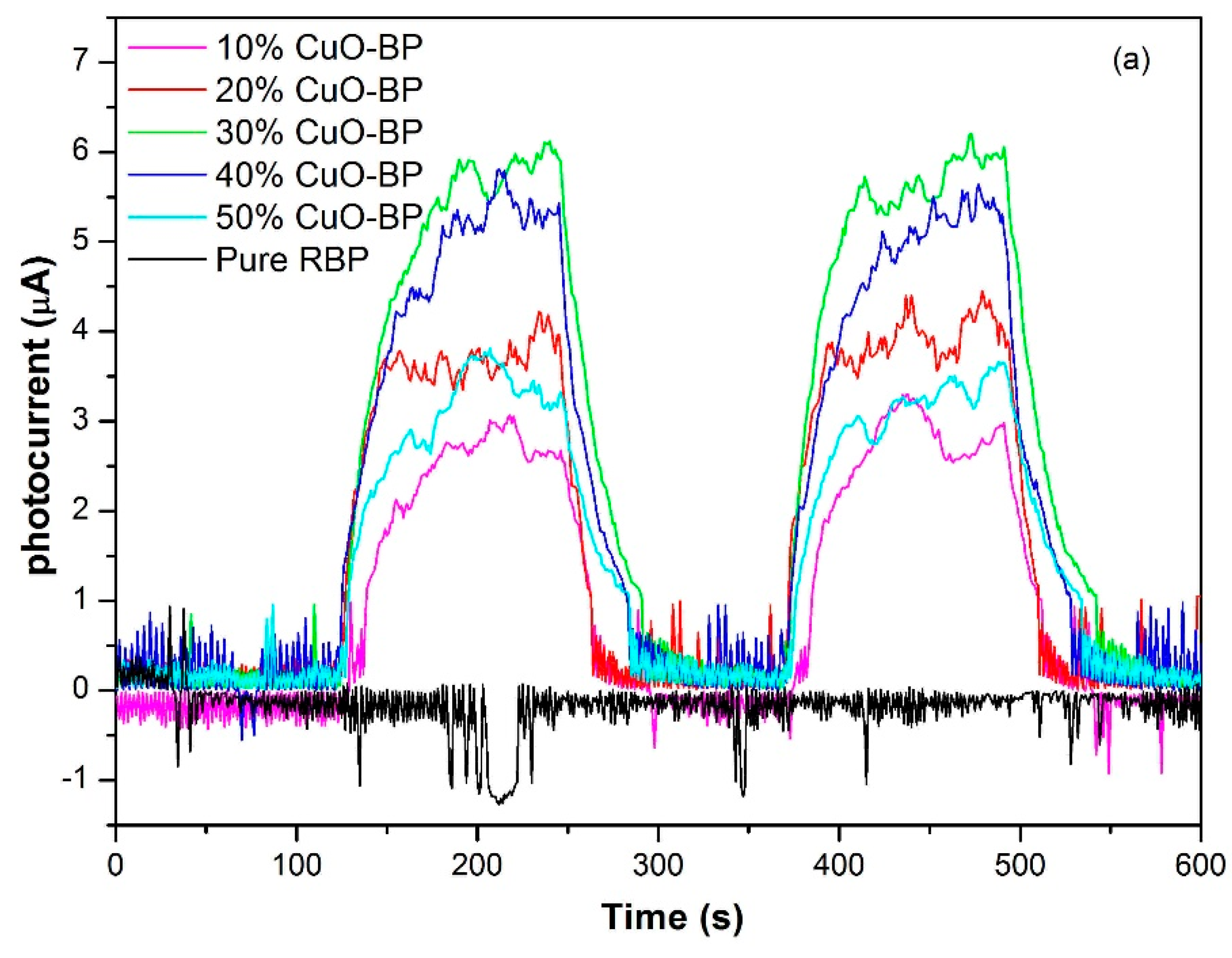
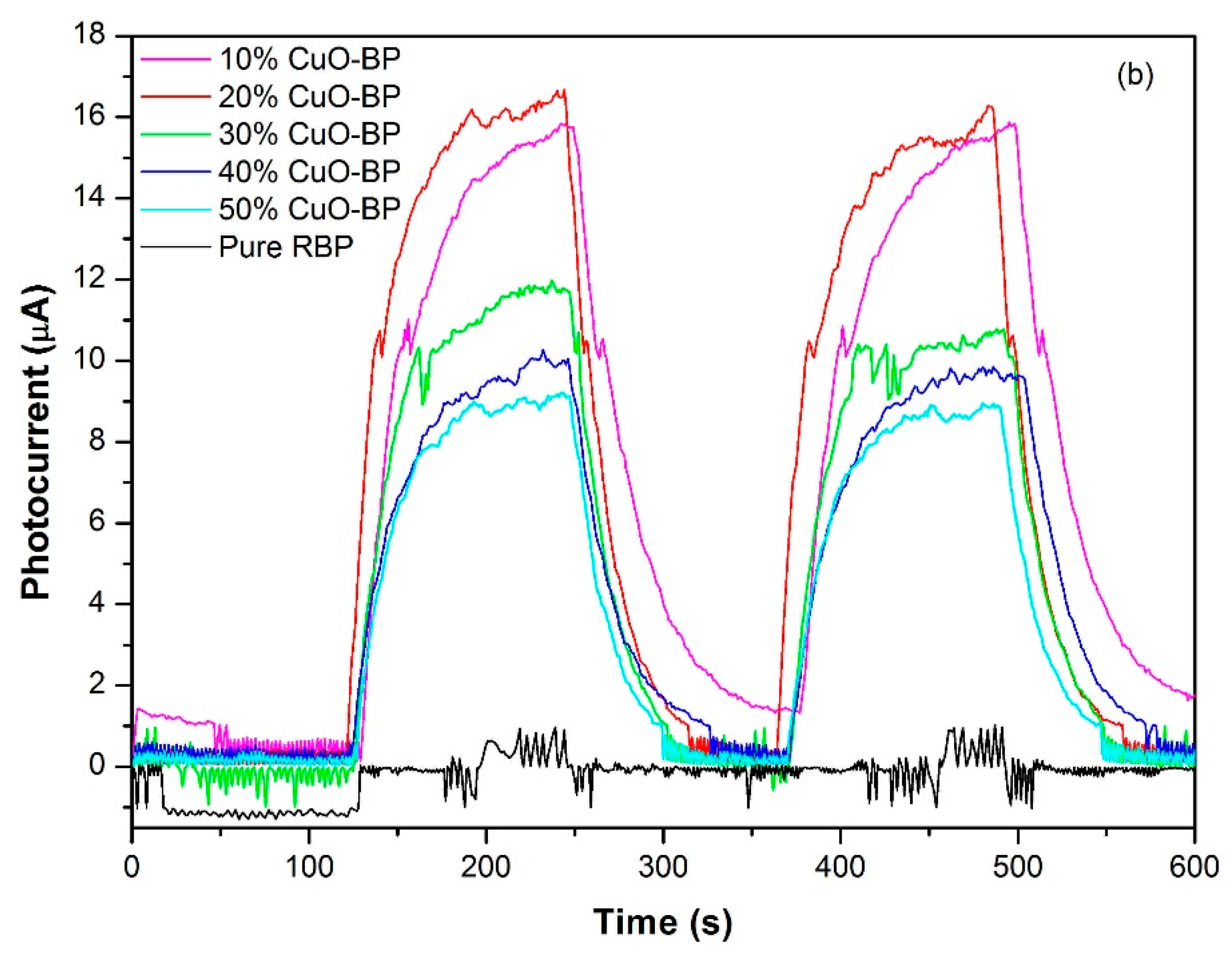
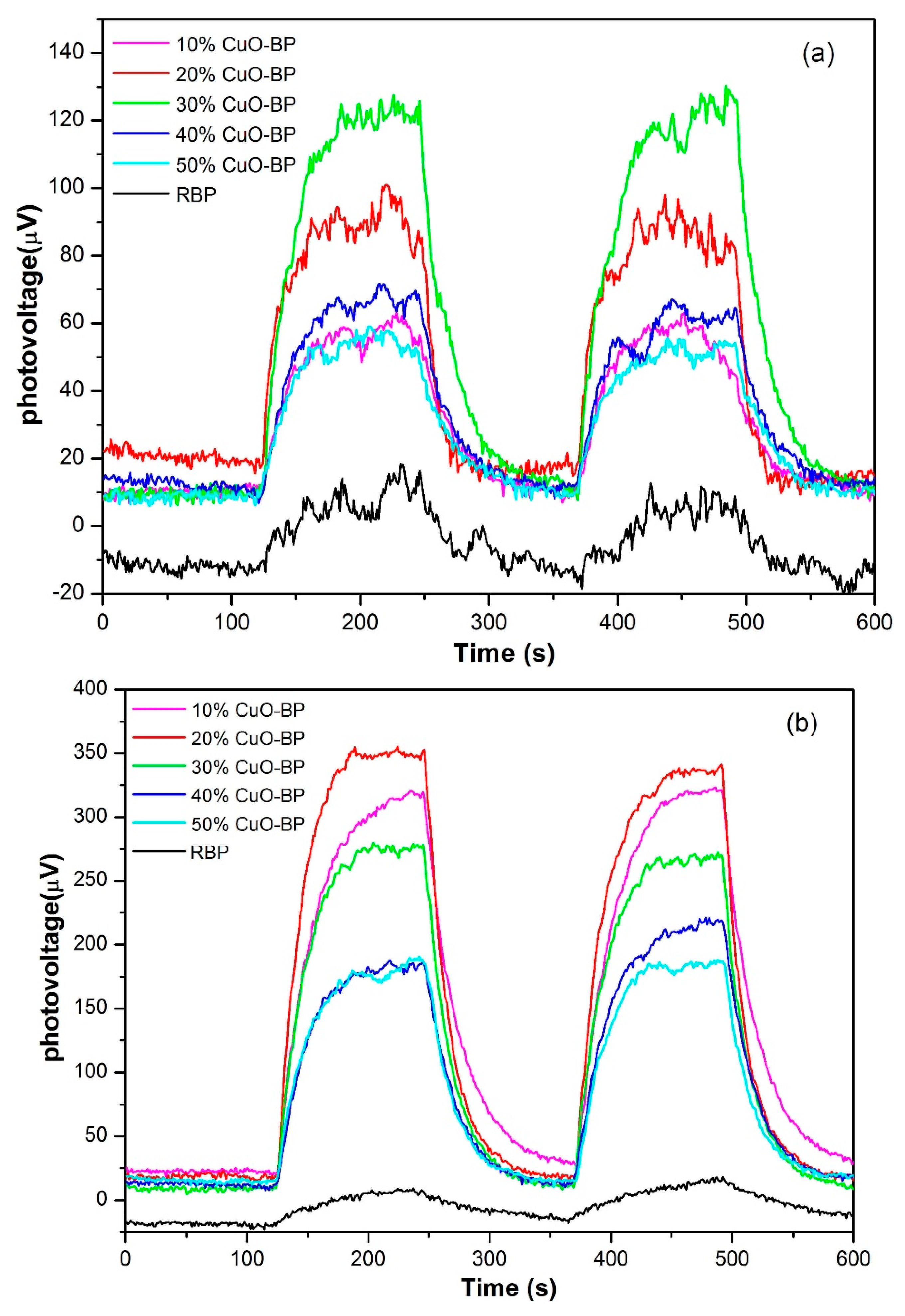
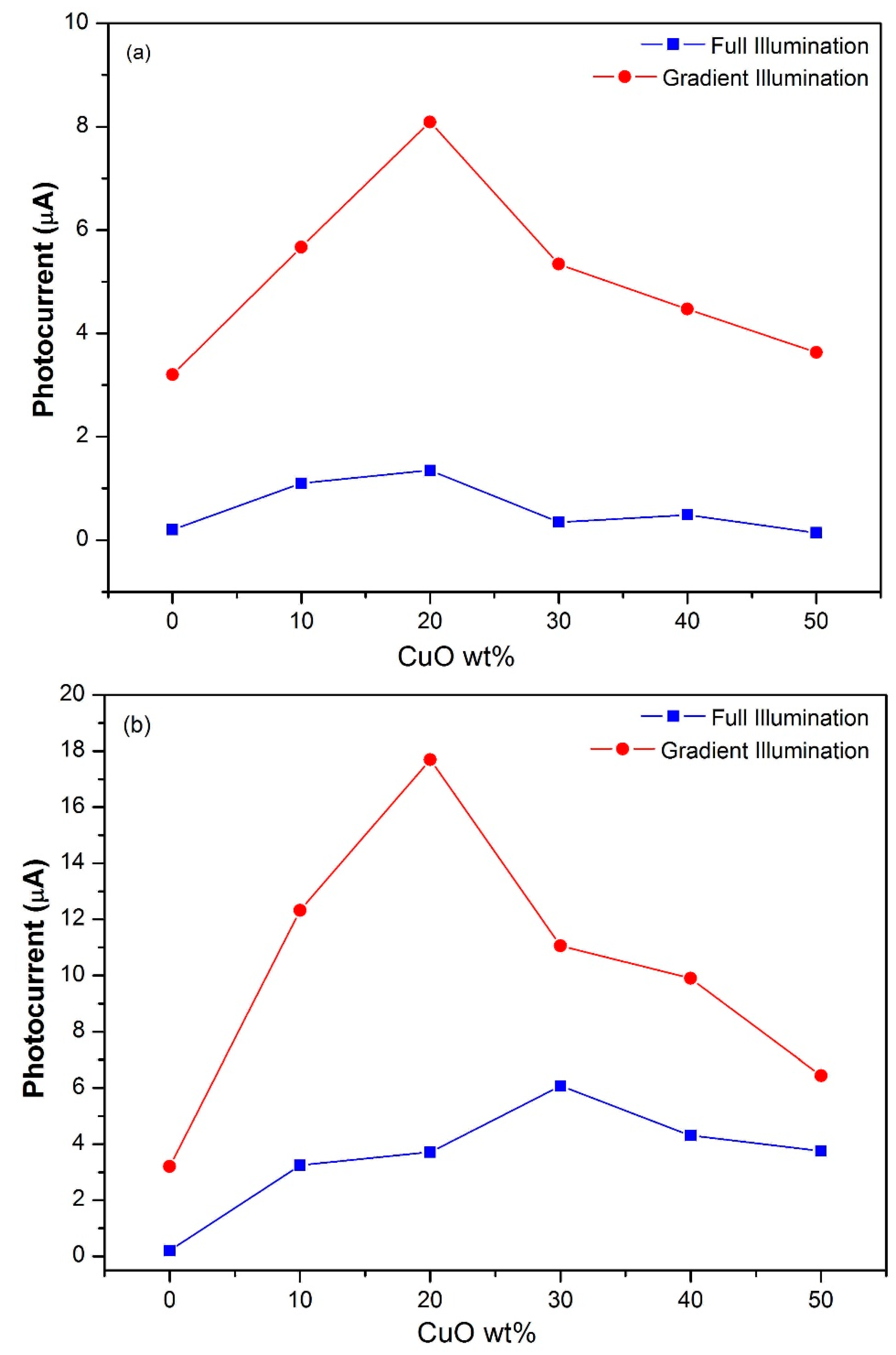

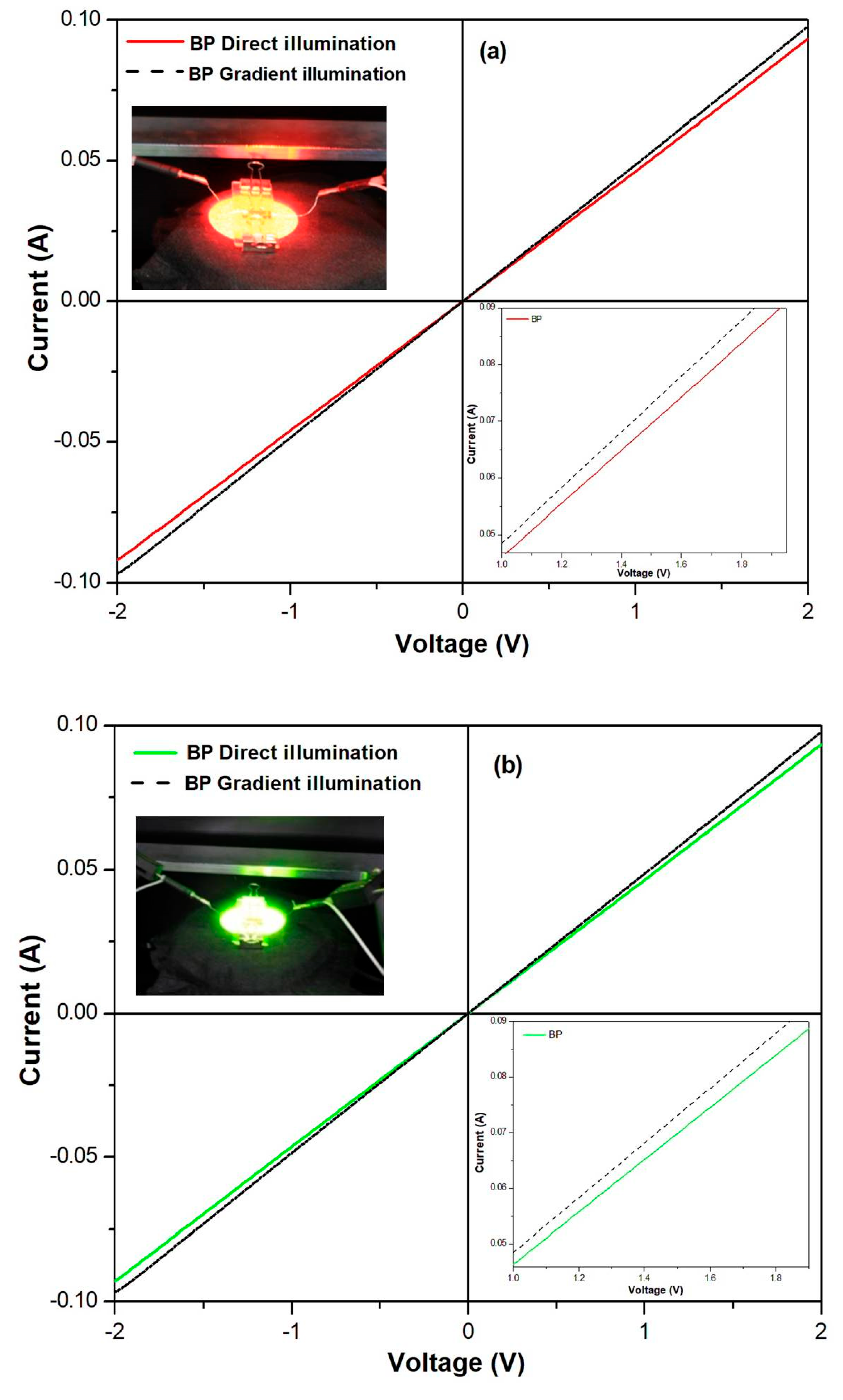
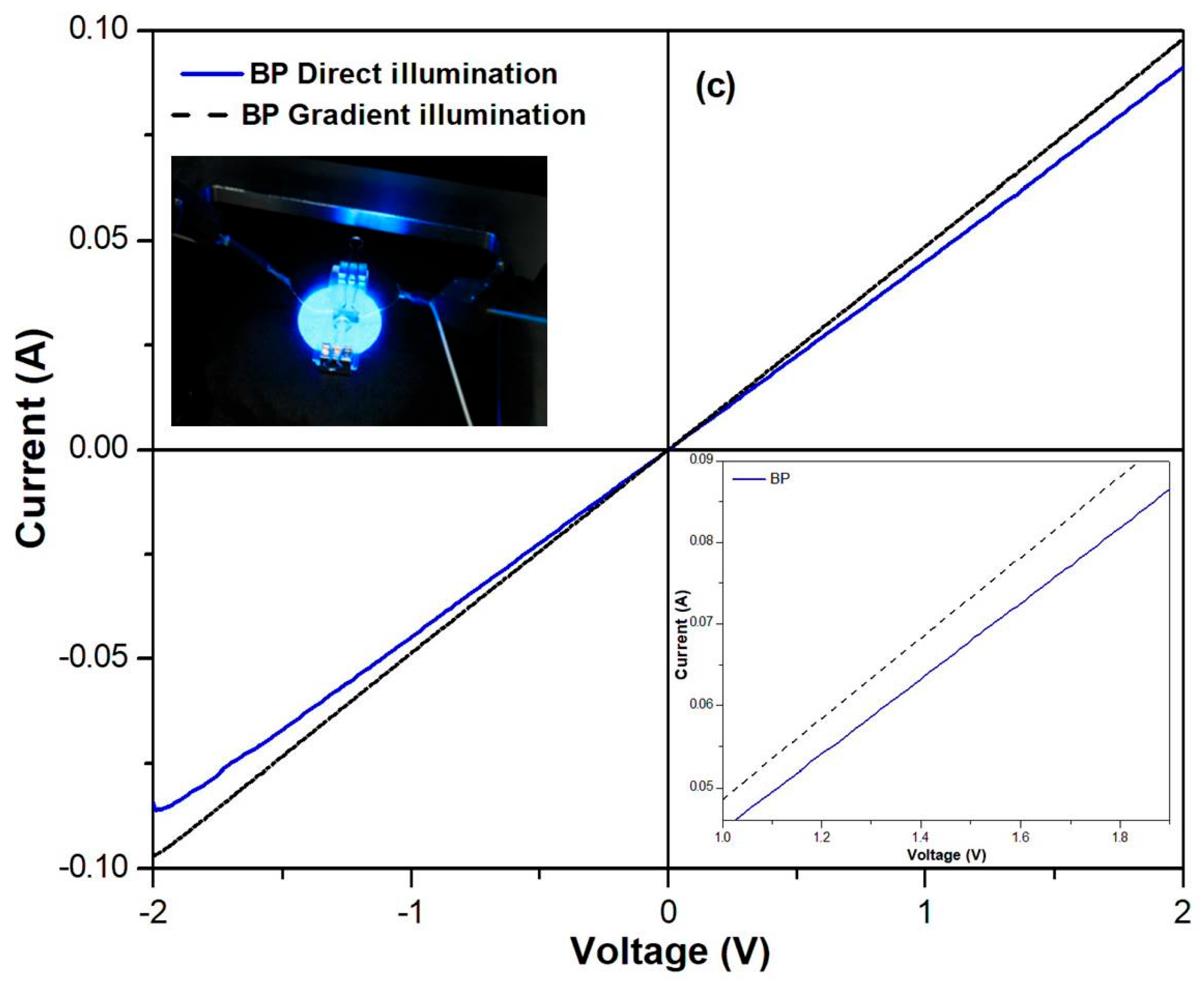
| Sample | Photocurrent Value | Bias Voltage | Ref. |
|---|---|---|---|
| Pure CuO | 2.38 µA | 30 V | 36 |
| DWCNT-CuO | 32 nA | 1 V | 24 |
| Cu-MWCNT | 900 nA | 12 mV | 37 |
| Cu2O-graphene | 1.9 mA | 0.05 V | 38 |
| CNT/Cu2O film on ITO | 450 µA | 0.1 V | 39 |
| CuO-BP | 17.69 µA | 0 V | This work |
Disclaimer/Publisher’s Note: The statements, opinions and data contained in all publications are solely those of the individual author(s) and contributor(s) and not of MDPI and/or the editor(s). MDPI and/or the editor(s) disclaim responsibility for any injury to people or property resulting from any ideas, methods, instructions or products referred to in the content. |
© 2025 by the authors. Licensee MDPI, Basel, Switzerland. This article is an open access article distributed under the terms and conditions of the Creative Commons Attribution (CC BY) license (https://creativecommons.org/licenses/by/4.0/).
Share and Cite
Saravanan, L.; Tu, W.-C.; Miao, H.-Y.; Liu, J.-H. High-Efficiency Photoresponse of Flexible Copper Oxide-Loaded Carbon Nanotube Buckypaper Under Direct and Gradient Visible Light Illumination. Processes 2025, 13, 188. https://doi.org/10.3390/pr13010188
Saravanan L, Tu W-C, Miao H-Y, Liu J-H. High-Efficiency Photoresponse of Flexible Copper Oxide-Loaded Carbon Nanotube Buckypaper Under Direct and Gradient Visible Light Illumination. Processes. 2025; 13(1):188. https://doi.org/10.3390/pr13010188
Chicago/Turabian StyleSaravanan, Lakshmanan, Wei-Cheng Tu, Hsin-Yuan Miao, and Jih-Hsin Liu. 2025. "High-Efficiency Photoresponse of Flexible Copper Oxide-Loaded Carbon Nanotube Buckypaper Under Direct and Gradient Visible Light Illumination" Processes 13, no. 1: 188. https://doi.org/10.3390/pr13010188
APA StyleSaravanan, L., Tu, W.-C., Miao, H.-Y., & Liu, J.-H. (2025). High-Efficiency Photoresponse of Flexible Copper Oxide-Loaded Carbon Nanotube Buckypaper Under Direct and Gradient Visible Light Illumination. Processes, 13(1), 188. https://doi.org/10.3390/pr13010188









